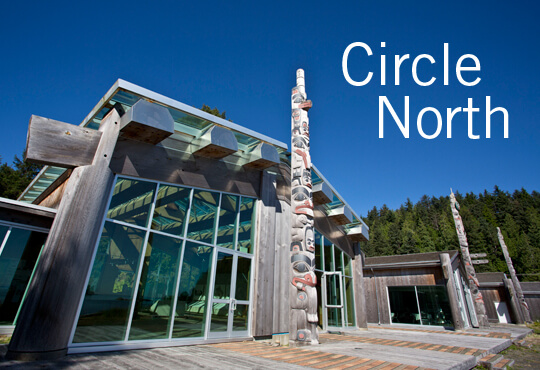 First Nations culture, fish, furs and gold rush fever—discover them all on this Northern BC tour. It’s just one option for exploring your own backyard in a province that’s bigger than Britain and France combined. Day trip or expedition, get out there and take a look. ~
First Nations culture, fish, furs and gold rush fever—discover them all on this Northern BC tour. It’s just one option for exploring your own backyard in a province that’s bigger than Britain and France combined. Day trip or expedition, get out there and take a look. ~
March/Spring 2013
Haida Gwaii ~
Shadows cast by the mellow evening light sharply defined the ridges, rolls and peaks to the west of the ferry landing at Skidegate on Graham Island. This is the largest and most northerly of the 150 some islands that make up the Haida Gwaii archipelago also known as the Queen Charlotte Islands. Driving the few kilometres into the ambitiously named Queen Charlotte City, I was immediately struck by indicators of the region’s independent spirit—a selection of roadside signs that left no doubt about local attitudes toward a northern pipeline.
Not that independence is a surprising characteristic for people who live at the farthest edge of Canada, separated from mainland BC by often-stormy Hecate Strait. For millennia before contact the Haida made such a handsome living from the abundant sea that their population likely topped 10,000 and they had plenty of free time for artistic pursuits. They developed a distinct language and mastered their isolation by carving superb canoes to carry their expert paddlers on regular trading missions to the area of present day Prince Rupert and as far along the coast as Alaska and Mexico.
The art and skill of canoe carving was nearly lost, along with so much of Haida culture, as successive waves of smallpox depopulated whole villages, reducing the population by as much as 90 per cent. Bill Reid is remembered for helping to reclaim that heritage with his famed canoe Loo Taas. A major focus of our trip was to learn more about current canoe carvers and to investigate Haida culture in general.
We took advantage of a rare sunny day to start by photographing a replica of Loo Taas, floating at a mooring in the bay facing the glass and beam longhouses of the Haida Heritage Centre. We spent time shooting the outdoor totem poles, but didn’t explore the interior exhibits because we planned to return for the Loo Taas 25th anniversary celebration in two days.
We spent those days exploring along Highway 16, a coastal road squeezed between pebble beaches and the practically impenetrable forest of towering cedar and spruce before it swings inland to the village of Port Clements and finally north to Masset and, at the top of the island, the Haida village of Old Masset.
There we met renowned argillite carver, Christian White, who is equally well known for his work in wood, including poles and canoes. He was immensely generous with his knowledge of Haida people and ways, illustrating every major point with a story, his delivery echoing the oral tradition of his ancestors. Christian passed us off to John Bennett, a carver and boat builder who invited us to join his family for Friday night dinner, Haida style: fresh crab, three salmon dishes, vegetables and huckleberry pie. Later we spent the night with Christian’s cousin, April White, an engineer turned artist whose work lines the walls of her Eagles Feast House B&B and sells from major galleries.
In our travels we found that artistry is imbedded in the Haida DNA. We expected talent from Christian, John and April. But then there was the two-storey totem in John’s living room, carved as an Emily Carr art school project by his son, and the eye-popping textiles designed by his wife Joyce who has been exhibited at the Canadian Museum of Civilization. At the Haida Centre, interpreters and even the manager all mentioned aspirations to attend or having already attended Emily Carr in addition to other degrees and qualifications. And being a part of the celebration at the Haida Centre drove the point home even more strongly as every generation proudly paraded in their best regalia.
Seeing the living culture of today made our daytrip Moresby Explorers boat tour from Morseby Island to the abandoned village of K’uuna Llanagaay (Skedans) on Louise Island even more poignant. As Haida watchman Walter Russ escorted us around the site, explaining the purpose and original appearance of the few standing poles and moss-covered remnants fast being reclaimed by the forest, I was haunted by the specter of a great culture nearly destroyed—and immensely heartened by it current strength and sense of renewal.
Highway 16 ~
We reconnected with Highway 16 on the mainland, leaving the Haida behind to meet their neighbours and trading partners the Tsimshian, Gitxsan and Carrier peoples and to explore the beginnings of modern BC.
The city of Prince Rupert was a huge surprise. From the activity of fishing boats in the harbour and the towering derricks of the container port (seen from the ferry), I had the idea this was purely a working town. I thought the only interesting tourist feature would be Cow Bay, where herds of day tripping Alaska cruise passengers crowd the cafés and shops on port day. But driving around, we found streets of attractive houses and downtown, the knockout art deco city hall decorated in unique aboriginal motifs.
Near the harbour, the Museum of Northern BC is constructed in the style of the traditional longhouse. It displays treasures of the Tsimshian along with exhibits that explain Prince Rupert’s connection with the Titanic and how the city came into being as the terminus for a railway that would eventually become the Canadian National.
Another aspect of coastal history is preserved just down the highway in Port Edward at the North Pacific Cannery National Historic Site. Established in 1889, the cannery operated for almost a century and is the oldest remaining fish cannery on the West Coast of North America. I was intrigued by the social history of the annual cannery lifestyle, where Chinese, Japanese and First Nations workers each played very separate roles under Euro-Canadian management.
On the drive east, more roadside signs declared environmental and political opinions and reminded us of the tragic events associated with the “highway of tears.” We moved into Gitxsan territory and the Ksan Village at the Hazeltons. Here a guide escorted us through Eagle, Wolf, Fireweed and Frog longhouses (named for the Gitxsan clans) where the tang of wood smoke touched the air as sound and light shows revealed the structure and lifestyle of the people.
The other highlight of the Hazeltons is the Visitor Centre, where kitschy figures represent different aspects of the local economy and JF serves twice-fried ambrosia from his chip truck.
Travelling on through history, Highway 16 often parallels ancient transportation routes that took on huge significance during the fur trade era. A short side-trip brought us to the Fort St. James National Historic Site. Founded in 1806 by Simon Fraser for the Northwest Company, the fort was the second permanent post west of the Rockies. It played an important role in Fraser’s preparations for his 1808 expedition to explore the river he hoped was the Columbia, but that now bears his name.
The Northwest and Hudson Bay companies merged in 1821 and from then until it ceased operations in 1952, Fort St. James was a pivotal Hudson Bay fur trading post. The site is restored to represent the year 1896 with interpreters setting the scene. I got so involved in conversation with Violet Prince, who greeted me in her native Carrier language at the Men’s House, and her daughter-in-law Lindsay Sam in the Trade Store, that I missed the chicken races—but I did get a fresh-baked ginger snap in the Officers’ House. And I learned something that several university courses on the fur trade had failed to impress on me. For at least half of the post’s long history, dried salmon supplied by the Carrier was the staple diet. Without help from the indigenous peoples, fur traders would quite simply have starved.
I also heard a couple of versions of the story of legendary Chief Kw’eh sparing the life of James Douglas, the man would otherwise not have become first governor of the newly formed colony of British Columbia in 1858.
My big disappointment at Fort St. James was learning too late that we could have stayed overnight in the Officer’s House B&B. Next time for sure.
Barkerville ~
To complete the circle, we made the big swing south onto Highway 97 at Prince George, but only for a quick run to Quesnel, where a hard left took us into the mountains and our final stop on the heritage trail. We pulled into Barkerville six days after the 150th anniversary of the gold strike Billy Barker registered on August 21, 1862.
Gold fever had already reached epidemic proportions. The Fraser Valley gold rush of 1858 had led to the creation of the colony of British Columbia to ward off American expansionism. The first strikes in Cariboo country were made in 1859 and 1860, but the rush didn’t gain momentum until word got out in 1861. Then, stand back.
With Billy Barker’s strike on Williams Creek, Barkerville was born. As a veteran of historic towns from Williamsburg to Upper Canada Village, I’m here to say that the largest historic site in our province is top drawer, with over 100 historic structures still standing and a cast of characters who wrote the book on bringing history to life.
We’d been warned to budget two days for our visit and getting smarter after the disappointment at Fort St. James, booked accommodations onsite at the Kelly and King House B&B, right on Main Street across from St. Saviour’s Church and the schoolhouse.
“Wecome to Cariboo” proclaimed a sign in Chinese characters over the arch that separates Chinatown from the rest of Barkerville. Having consulted our daily activities schedule, we’d decided to join the Chinatown tour. Archeologist Ying-Ying Chen guided us on an utterly fascinating walk through Cino-Euro relations in colonial times. Startling to our Euro-centric worldview was the notion that the Chinese regarded the indigenous people with favour because they belonged there, while our Euro-ancestors were foreign devils to be kept at bay. According to Ying-Ying, the segregated Chinatown was as much their idea as it was that of their neighbours.
Working our way backwards to the Barkerville orientation, we began to meet the cast of street players who would speak to us in terms of “my time (1862)” and “your time (2012)”. We chatted with them so frequently that they finally broke down and talked frankly about real life at Barkerville.
One player who lives in nearby Wells and moves to Barkerville for the summer, said the end of the season is like “having a Victorial rug pulled out from under you.”
Miss Playfair (Lynette Candy), whose lively repartee with Mr. Grimsby (Dave Brown) at the Cornish waterwheel keeps even fidgety kids riveted, said, “I put my first dress [costume] on when I was five.” Her dad was chief conservator. As a kid, Lynette and the 19 other kids on site had to be in school in the morning, but “afternoons we were expected to be at a display being helpful.”
Mr. Grimsby’s been on the waterwheel for 25-plus seasons and the two of them have wracked up 52 seasons at the historic site.
Barkerville is a small world indeed. Attilla Kallai, the lively, loveable drunk we dubbed Johnny Depp, turned out to be engaged to Tracy Froese, the lady in red. And James Douglas (no relation to the former colonial governor), who manages the place, has produced twin actors-of-the-future with Danette Boucher—The Bride of Barkerville.
Talk about entertainment with lots of laughter and a few tears. Danette’s one-woman show depicting the life of Florence Wilson so enthralled me that I came home and bought a book about the bride ships. Yes, Florence’s tale is the story of a woman brought to this country to help stabilize the overwhelmingly male society by providing wives so the men could settle down to family life. But Florence had other ideas. What a story!
A session in court where Judge Matthew Baillie Begbie (Timothy Sutherland) soundly upbraided me for taking a photo without asking, “May I,” wrapped up in the saloon where we shared a pint with his honour and his clerk Peter O’Reilly (Stewart Cawood), both long-term Barkerville veterans and passionate about their roles. Like the other players, they’ve meticulously researched their characters and these two were quick to defend Begbie, who they assert was unjustly known as “the hanging judge,” but who did bring law and order to the colony,
For great family entertainment and easy-learning history, no British Columbian should miss Barkerville.
BC Ferries: Vital Link ~
BC Ferries operates crucial links for any Northern BC circle tour. For me, the 15-hour Inside Passage cruise from Port Hardy at the northern tip of Vancouver Island to Prince Rupert on the North Coast was a voyage I’d longed to make. And I was equally excited about the crossing of the potentially wild Hecate Strait from Prince Rupert to Skidegate on Haida Gwaii.
A heavy overcast and remnants of a light drizzle didn’t augur well for the scenic element of our trip on Northern Expedition as we boarded in the dark. The vessel felt different from the short-trip ferries between the mainland and the Island as we sought the passenger lounges via passages lined with numbered cabins. I was kicking myself for not investigating this option, then gave in to a sudden impulse and headed for the purser’s desk. What a difference it made to abandon laptops and at least some of our camera gear and move freely on deck throughout the day. And I can’t say enough about the opportunity to stretch out on a comfy bunk to write my notes and snatch a little nap. In future, I’ll definitely book a cabin in advance.
Apparently the stars were in perfect alignment that day, because an hour into the voyage, patches of blue began to appear behind rips in the clouds. From then until the dazzling sunset, we sailed under clear skies. For a time we lounged on the sheltered sun deck, chatting with passengers we would meet again the next day on the run to Haida Gwaii. One family was on a combination of BC Ferries Vacations package tours that included their shore accommodations.
We dashed to the railings to watch eagles, porpoises, humpbacks and, to me the biggest thrill, a rare sea otter lolling on its back in the gentle swell.
We didn’t bother taking in the afternoon movie in The Raven Lounge, but I did browse the well-stocked gift shop, we ate breakfast and lunch in the Canoe Cafe and treated ourselves to table linens, Okanagan wine and a top-drawer buffet in the Vista Restaurant for dinner, complete with dolphin seashow beyond the expansive windows.
After a shoreside overnight in Prince Rupert, I got us fixed up with a cabin first thing when we boarded Northern Adventure heading for Haida Gwaii. This voyage offered less mountain scenery, but I did get to know one particular humpback very well. We sailed from sunny warmth in Port Hardy through a cool damp wall of fog to more sunshine beyond. The waters of Hecate Straight remained obstinately peaceful (I love a good blow) and sunset gold touched the totems on the shoreline near Skidegate seven hours later. It was great knowing we still had the return trip to look forward to.
On this trip I ticked three items off my bucket list—the Inside Passage, Haida Gwaii and Barkerville—and realized that other stops should have been on it. In BC, there’s just so much to discover.



0 Comments